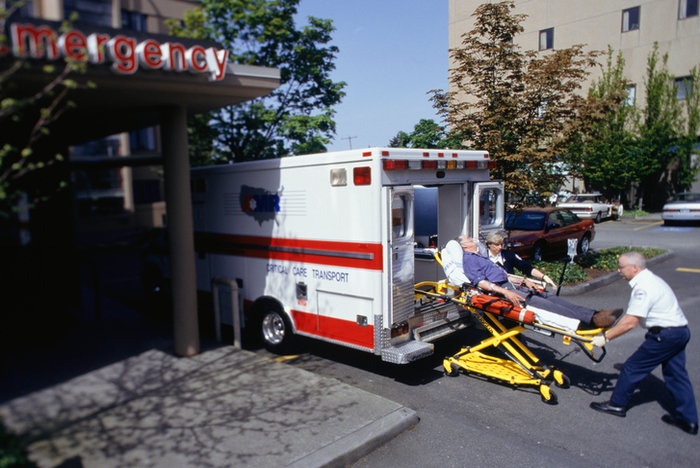
When you think about treating patients with head injuries, using an emergency suction pump may not be the first thing that comes to mind. Certainly, airway is your main priority, but we tend to focus more on level of consciousness, spinal immobilization, and assessing for additional trauma than we do on portable suction.
But using an emergency suction pump is key to managing patients with head injuries. Today, we’ll discuss some of the critical steps in treating these devastating injuries.
The Brain: An Overview
The brain is divided into three main areas, each of which controls specific physiological processes. They are:
- Cerebellum – located beneath the occipital lobe; controls coordination and balance
- Cerebrum – divided into right and left hemispheres and is composed of the following lobes:
- Frontal – controls emotions, motor function, and the expression of speech on the dominant side (in most individuals, the left hemisphere)
- Parietal – controls sensory function and spatial orientation
- Temporal – regulates certain memory functions; contains the area for speech reception and integration in most individuals (all right-handed individuals and the majority of left-handed)
- Occipital – contains the visual center of the brain
- Brainstem – where the brain merges with the spinal cord. It is divided into the:
- Midbrain and upper pons – contain the reticular activating system, which is responsible for arousal and alertness
- Medulla oblongata – contains the cardiorespiratory centers
Traumatic injury to any part of the brain can lead to respiratory emergencies, by disrupting the control centers for respiration; by reducing the level of consciousness, leading to unprotected airways; or by impeding the sensory apparatus that monitors oxygen levels in the blood.
The First Step: A Thorough Assessment
As with any traumatic injury, the first step in treating head injuries involves a thorough patient assessment. Begin with the primary survey—the A, B, C, D, and E:
Airway: Check for patency; listen for noisy ventilations, which can indicate obstruction; and use your emergency suction pump to remove any blood, vomitus, or tissue that may be present.
Breathing: Evaluate respiratory function by assessing the rate, depth, and adequacy of breathing. Head injuries may produce abnormal breathing patterns, which include:
- Cheyne–Stokes – a cyclic pattern characterized by increases in rate and depth, followed by periods of apnea
- Ataxic breathing – an irregular form of Cheyne–Stokes respirations
- Cluster breathing – a cluster of irregular respirations, varying in depth, followed by periods of apnea
- Apneustic breathing – prolonged, gasping inspiration followed by brief, ineffective expirations
- Agonal respirations – deep, slow, shallow, and irregular breathing; may be gasping
Circulation: The goal in head trauma is to maintain a systolic blood pressure greater than 90 mm Hg, to prevent secondary brain injury. A slow, forceful pulse may result from intracranial hypertension, possibly indicating impending herniation.
Disability: Assess the level of consciousness and determine the position on the Glasgow Coma Scale. Record each component of the score individually, to gauge changes in the patient’s condition over time.
Exposure/Environment: Check for any additional traumatic injuries. The primary assessment should be followed by a thorough secondary assessment, to include a SAMPLE history (symptoms, allergies, medications, past history, last meal, and events). Be sure to reassess continuously, because the patient’s condition can change rapidly.
The Second Step: Managing the Airway
Patients with traumatic head injuries are prone to respiratory emergencies. An unprotected airway, secondary to loss of consciousness, is predisposed to obstruction, from the tongue, hemorrhage, or vomit. Your emergency suction pump is a critical tool in managing these tenuous airways.
Recognize the signs of respiratory distress. They include:
- Mild anxiety
- Minimal cyanosis
- Tachycardia, possible chest tightness
- Altered breath sounds
- Decreased O2 saturation
Stay alert for signs of respiratory failure and be prepared to intubate. Signs of failure include:
- Altered mental status, which may also be caused by the head trauma
- Retractions or use of accessory muscles
- Tachycardia >130 bpm
- Decreased O2 saturation, even with oxygen therapy
- Pale skin and diaphoresis
- Absent breath sounds
- Cyanosis
- Abnormal respiratory patterns
If the patient requires an advanced airway, be sure to keep the suction unit nearby. You will need it to maintain patency while you assemble your equipment, to visualize the cords prior to tube placement, and to ensure the airway remains clear, once the patient has been intubated.
Your emergency suction pump is part of each critical step in treating patients with head injuries, so be sure to bring the unit along. Better yet, include a suction unit in your trauma bag so that it accompanies you on every trauma call.
2011
Prehospital Trauma Life Support, American College of Surgeons, Committee on Trauma, MOSBY JEMS, Elsevier.














